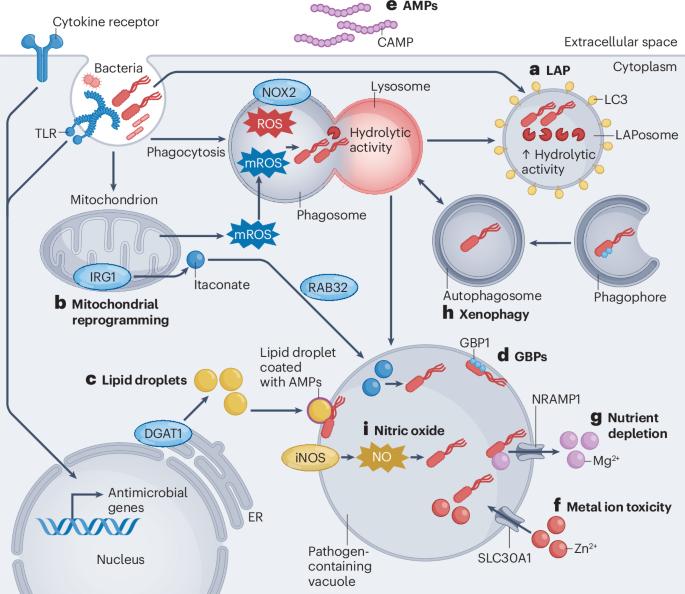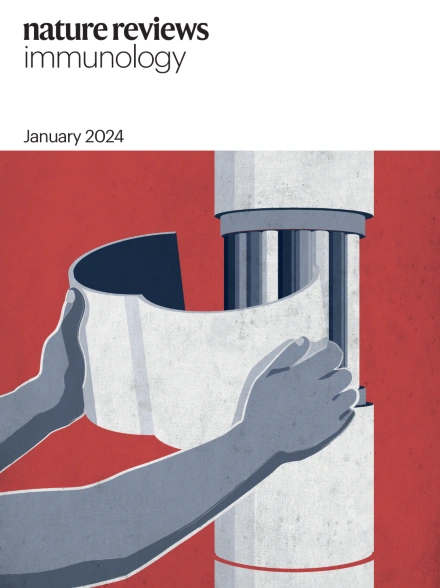Inducible antibacterial responses in macrophages
IF 67.7
1区 医学
Q1 IMMUNOLOGY
引用次数: 0
Abstract
Macrophages destroy bacteria and other microorganisms through phagocytosis-coupled antimicrobial responses, such as the generation of reactive oxygen species and the delivery of hydrolytic enzymes from lysosomes to the phagosome. However, many intracellular bacteria subvert these responses, escaping to other cellular compartments to survive and/or replicate. Such bacterial subversion strategies are countered by a range of additional direct antibacterial responses that are switched on by pattern-recognition receptors and/or host-derived cytokines and other factors, often through inducible gene expression and/or metabolic reprogramming. Our understanding of these inducible antibacterial defence strategies in macrophages is rapidly evolving. In this Review, we provide an overview of the broad repertoire of antibacterial responses that can be engaged in macrophages, including LC3-associated phagocytosis, metabolic reprogramming and antimicrobial metabolites, lipid droplets, guanylate-binding proteins, antimicrobial peptides, metal ion toxicity, nutrient depletion, autophagy and nitric oxide production. We also highlight key inducers, signalling pathways and transcription factors involved in driving these different antibacterial responses. Finally, we discuss how a detailed understanding of the molecular mechanisms of antibacterial responses in macrophages might be exploited for developing host-directed therapies to combat antibiotic-resistant bacterial infections. Macrophages are innate immune sentinels providing frontline defence against infection. This Review describes the inducible mechanisms used by macrophages to kill bacterial pathogens and/or inhibit their growth and outlines how this knowledge might be exploited in the design of host-directed therapies.



巨噬细胞中的诱导抗菌反应
巨噬细胞通过吞噬耦合抗微生物反应来消灭细菌和其他微生物,如产生活性氧和将水解酶从溶酶体输送到吞噬体。然而,许多细胞内细菌会颠覆这些反应,逃到其他细胞区生存和/或复制。这种细菌颠覆策略是通过一系列额外的直接抗菌反应来对抗的,这些反应由模式识别受体和/或宿主衍生的细胞因子和其他因子启动,通常是通过诱导基因表达和/或代谢重编程来实现的。我们对巨噬细胞中这些诱导性抗菌防御策略的了解正在迅速发展。在本综述中,我们将概述巨噬细胞可采取的各种抗菌反应,包括 LC3 相关的吞噬作用、代谢重编程和抗菌代谢物、脂滴、鸟苷酸结合蛋白、抗菌肽、金属离子毒性、营养耗竭、自噬和一氧化氮的产生。我们还强调了参与驱动这些不同抗菌反应的关键诱导剂、信号通路和转录因子。最后,我们将讨论如何利用对巨噬细胞抗菌反应分子机制的详细了解来开发宿主导向疗法,以对抗耐抗生素细菌感染。
本文章由计算机程序翻译,如有差异,请以英文原文为准。
求助全文
约1分钟内获得全文
求助全文
来源期刊

Nature Reviews Immunology
医学-免疫学
CiteScore
93.40
自引率
0.40%
发文量
131
审稿时长
6-12 weeks
期刊介绍:
Nature Reviews Immunology is a journal that provides comprehensive coverage of all areas of immunology, including fundamental mechanisms and applied aspects. It has two international standard serial numbers (ISSN): 1474-1733 for print and 1474-1741 for online. In addition to review articles, the journal also features recent developments and new primary papers in the field, as well as reflections on influential people, papers, and events in the development of immunology. The subjects covered by Nature Reviews Immunology include allergy and asthma, autoimmunity, antigen processing and presentation, apoptosis and cell death, chemokines and chemokine receptors, cytokines and cytokine receptors, development and function of cells of the immune system, haematopoiesis, infection and immunity, immunotherapy, innate immunity, mucosal immunology and the microbiota, regulation of the immune response, signalling in the immune system, transplantation, tumour immunology and immunotherapy, and vaccine development.
 求助内容:
求助内容: 应助结果提醒方式:
应助结果提醒方式:


